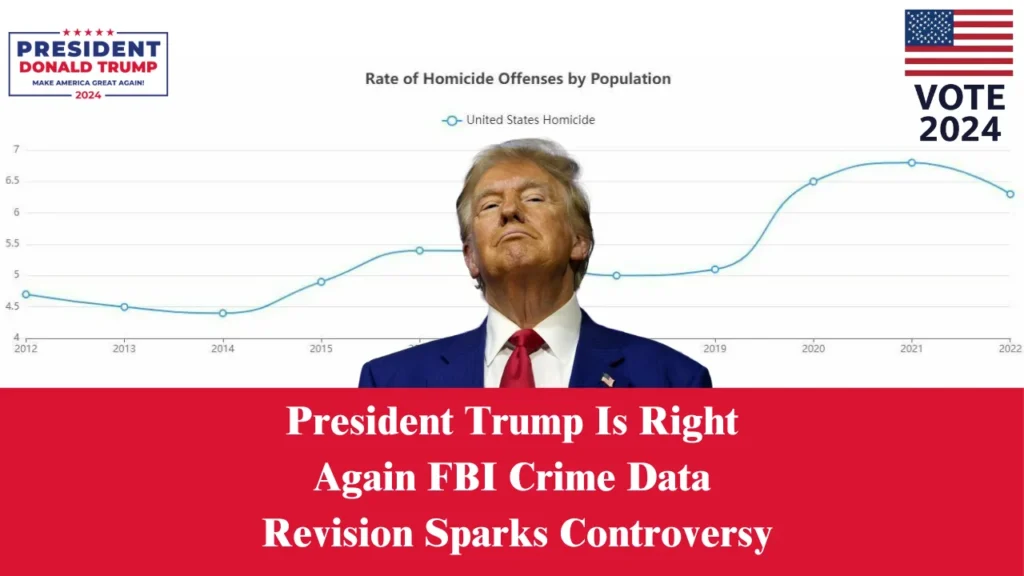Trump Is Right: FBI Crime Data Revision Sparks Controversy
A recent FBI crime data revision has reignited debate over crime rates in the U.S., suggesting that former President Donald Trump‘s warnings about rising violent crime were more accurate than initially believed.
A new report shows that the FBI quietly updated its 2022 crime data, revising what was initially reported as a 2.1% decrease in violent crime to a 4.5% increase – a significant shift that calls into question the narrative many Democrats, including Vice President Kamala Harris, have used to downplay crime concerns.
In this article, I explained what are the new stats found in this FBI crime data revision and how they prove President Trump’s claim of “crime has been on the rise” to be right.

FBI’s Quiet Crime Data Revision
When the FBI first released its “final” crime report for 2022 in September 2023, it touted a 2.1% drop in violent crime. This figure quickly became a key talking point for Democrats, who sought to counter former President Trump’s claims of skyrocketing crime under the current administration.
However, behind the scenes, the FBI later revised this data, revealing a starkly different picture. Violent crime in 2022 didn’t fall but actually increased by 4.5%, including thousands more murders, rapes, robberies, and aggravated assaults than previously reported.
What’s striking is how quietly the FBI made this change. There was no mention of the revision in any public statements, including its September 2024 press release.
Instead, the update was tucked away on the FBI’s website with only a cryptic note indicating that the 2022 violent crime rate had been “updated for inclusion” in the 2023 report. It wasn’t until researchers and investigators compared the updated data with the prior report that the change was noticed.
Discrepancies Raise Concerns About Transparency
This significant shift in crime data has raised eyebrows among crime experts and researchers. “There were no major revisions in violent crime data from 2004 to 2020, but the changes in 2021 and 2022 are massive and unexplained,” said Carl Moody, a professor at the College of William & Mary who specializes in crime statistics.
The sudden and unexplained alterations, particularly a jump from a reported decrease to a sharp increase in violent crime, have led to questions about the FBI’s methodology and transparency.
Experts like Dr. Thomas Marvell, president of Justec Research, have echoed these concerns, calling on the FBI to explain the large revisions. But as of now, the Bureau has remained silent, declining to respond to repeated inquiries.
Extensive Revisions in FBI Crime Stats
The changes in the FBI’s updated data are significant. According to the revised numbers, there were 80,029 more violent crimes in 2022 than in 2021, including 1,699 more murders, 7,780 more rapes, 33,459 additional robberies, and 37,091 more aggravated assaults.
These are not minor adjustments – these are major increases in the crime rate that completely reverse the previously reported decline.
Without these increases, the reported drop in violent crime for 2023 would also be far smaller – only 1.6% instead of the claimed 3.5% decrease. This has sparked further skepticism about the accuracy of the FBI’s future crime reports, leaving many wondering whether we can trust the Bureau’s crime data at all.
Use our US Elections GPT to get non-partisan analysis of recent election polls, public sentiments, different political parties’ agendas and stay upto-dated.
A Broader Pattern of Crime Data Revision
The FBI isn’t the only agency to face scrutiny over revised data. The Bureau of Labor Statistics recently admitted to overestimating the number of jobs created during the year ending in March by a staggering 818,000.
These revisions add to a broader pattern of questionable data that is often used as a political tool to frame narratives about the state of the country.
The FBI’s method of estimating crime rates, which relies heavily on extrapolating incomplete data from police departments, has long been a subject of controversy. Jeffrey Anderson, who headed the Department of Justice’s Bureau of Justice Statistics from 2017 to 2021, pointed out that the FBI’s processes for estimating crime have long been shrouded in secrecy, even from other government agencies.
Anderson said that under his leadership, any significant change in crime data, like the 6.6% swing from a decline to an increase in violent crime, would have been immediately highlighted in a press release.
Trump’s Warnings Vindicated?
For many, this revelation supports Trump’s longstanding claims that crime has been on the rise, despite attempts to downplay or obscure reality.
Throughout his presidency and beyond, Trump has repeatedly warned about rising crime and the need for stronger law enforcement policies, a message that resonated with many Americans concerned about public safety.
Democrats, including Kamala Harris, have often countered Trump’s warnings by pointing to official crime statistics that seemed to tell a different story. But with the FBI’s revised data now showing a significant increase in violent crime, Trump’s critics may have to reconsider their arguments.
Harris, in particular, has faced criticism for her record on crime and her past support for policies like “defund the police,” which some argue would only exacerbate the problem.
Discover what Trump revealed in Joe Rogan’s podcast and what key economic policies he talked about.
Final Thoughts
The FBI’s quiet revision of its 2022 crime data raises serious questions about the accuracy of crime statistics and the narratives built around them. As crime remains a top concern for voters heading into the next election, this new data will likely fuel further debate about the effectiveness of current policies and whether Trump’s tough-on-crime stance was justified.
With the FBI’s credibility now in question, the need for transparency and accuracy in crime reporting has never been more critical.
James Oliver
James Oliver is a seasoned political journalist, known for delivering insightful, balanced reporting on national and international politics. He simplifies complex issues, covering elections, policy reforms, and diplomacy with clarity and depth. His work emphasizes accuracy, accessibility, and truth, fostering trust and empowering readers with well-researched information.

